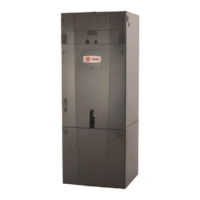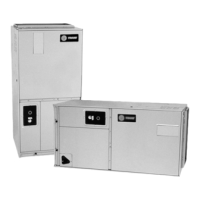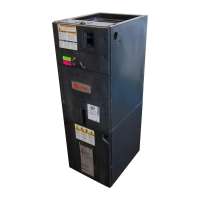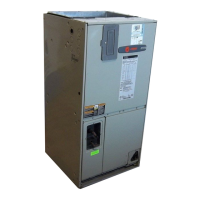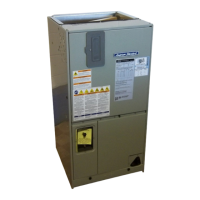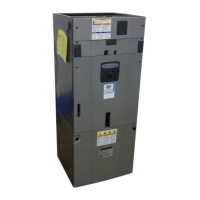BCX-SVX002A-EN
111
Table 36. Modulating outdoor air damper position setpoint determination
Occupancy BAS-communicated Setpoint Fan speed Active Minimum Setpoint
Unoccupied Any value Any value 0 percent (closed)
Occupied
Occupied bypass
Occupied standby
Valid
Any value
BAS-communicated
Occupied
Occupied bypass
Occupied standby
Invalid Low
Occupied low fan minimum
Occupied
Occupied bypass
Invalid
Medium/high Occupied minimum
Occupied standby
Invalid
Medium/high Occupied standby minimum
Table 37. Relationship between outdoor temperature sensors and damper position
Outdoor Air Temperature
Modulating outdoor air damper position
Occupied or Occupied Bypass Occupied Standby Unoccupied
No or invalid outdoor air
temperature
Open to occupied minimum position Open to occupied standby minimum position
Closed
Failed outdoor air sensor
Open to occupied minimum position Open to occupied standby minimum position
Closed
Outdoor air temperature
present and economizing
possible (Refer to
“Economizing (Free
Cooling),” p. 111)
Economizing; damper controlled between
occupied minimum position and 100 percent
Economizing; damper controlled between
occupied standby minimum position and 100
percent
Open and economizing during
unit operation; otherwise
closed
Outdoor air temperature
present and economizing not
possible (Refer to
“Economizing (Free
Cooling),” p. 111)
Open to occupied minimum position Open to occupied standby minimum position
Closed
Economizing (Free Cooling)
Cooling with outdoor air (during the times when the
temperature is low enough to allow) is referred to as
economizing (free cooling). The controller and applications
with modulating outside air damper, support economizing.
The modulating outdoor air damper provides the first
source of cooling for the controller.
The controller initiates economizing if the outdoor air
temperature is below the economizer enable point
(configurable using the Tracer
®
TU service tool). If
economizing is initiated, the controller modulates the
outdoor air damper (between the active minimum damper
position and 100 percent) to control the amount of outdoor
air cooling capacity. When the outdoor air temperature
rises 5°F (2.8°C) above the economizer enable point, the
controller disables economizing and moves the outdoor air
damper back to its predetermined minimum position, based
on the current occupancy mode or communicated minimum
outdoor air damper position. If an outdoor air temperature
value is not present, economizing is disabled.
Electric Heat Operation
The controller supports both SCR (modulating) and staged
electric heat (1- or 2-stages). In a unit configured with
staged electric heat, the electric heating circuit(s) are
cycled ON and OFF appropriately to maintain the desired
space temperature at the active heating setpoint. In a unit
configured with SCR (modulating) electric heat, the
controller will send a 0 to 10 Volt DC signal to adjust SCR
capacity in order to maintain the desired space
temperature.
In both staged and modulating electric heat applications,
the simultaneous use of electric and hydronic heat is not
supported and the controller will operate electric heat only
when hot water is not available (for example, in a
changeover unit). In addition, the controller will run the
supply fan for 30 seconds after electric heat is turned OFF
in order to dissipate heat from the unit.
Note: This delay does not apply to hydronic heating.
Factory-configured electric heat units have built-in
mechanical protections to prevent dangerously high
discharge air temperatures.
Start-Up
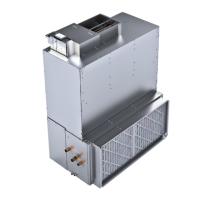
